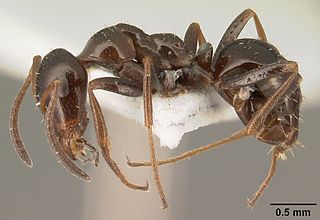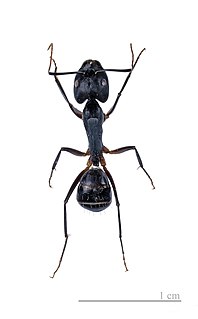
The Formicinae are a subfamily within the Formicidae containing ants of moderate evolutionary development.

Ponerinae is a subfamily of ants in the Poneromorph subfamilies group, with about 1,600 species in 47 extant genera, including Dinoponera gigantea - one of the world's largest species of ant. Mated workers have replaced the queen as the functional egg-layers in several species of ponerine ants. In such queenless species, the reproductive status of workers can only be determined through ovarian dissections.

Myrmicinae is a subfamily of ants, with about 140 extant genera; their distribution is cosmopolitan. The pupae lack cocoons. Some species retain a functional sting. The petioles of Myrmicinae consist of two nodes. The nests are permanent and in soil, rotting wood, under stones, or in trees.

Dolichoderinae is a subfamily of ants, which includes species such as the Argentine ant, the erratic ant, the odorous house ant, and the cone ant. The subfamily presents a great diversity of species throughout the world, distributed in different biogeographic regions, from the Palearctic, Nearctic, Afrotropical region and Malaysia, to the Middle East, Australian, and Neotropical regions.

Pachycondyla is a ponerine genus of ants found in the Neotropics.
Paleontology or palaeontology is the study of prehistoric life forms on Earth through the examination of plant and animal fossils. This includes the study of body fossils, tracks (ichnites), burrows, cast-off parts, fossilised feces (coprolites), palynomorphs and chemical residues. Because humans have encountered fossils for millennia, paleontology has a long history both before and after becoming formalized as a science. This article records significant discoveries and events related to paleontology that occurred or were published in the year 1967.

Aneuretinae is a subfamily of ants consisting of a single extant species, Aneuretus simoni, and 9 fossil species. Earlier, the phylogenetic position of A. simoni was thought to be intermediate between primitive and advanced subfamilies of ants, but recent studies have shown it is the nearest living relative of subfamily Dolichoderinae.
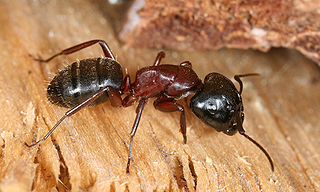
Camponotini is a tribe containing 2 extinct ant genera and 8 extant ant genera, including Camponotus.

Dolichoderus is a genus of ants found worldwide.

Sphecomyrminae is an extinct subfamily of ants in family Formicidae known from a series of Cretaceous fossils found in North America, Europe, and Asia. Sphecomyrminae contains ten genera, divided into two tribes, Haidomyrmecini and Sphecomyrmini. The tribe Haidomyrmecini contains the five genera Ceratomyrmex, Haidomyrmex, Haidomyrmodes, Haidoterminus and Linguamyrmex, while Sphecomyrmini contains Baikuris, Cretomyrma, Dlusskyidris, Sphecomyrma, and Zigrasimecia. The genus Sphecomyrmodes was formerly placed into Sphecomyrmini; however, in 2016, it was made a synonym of the stem group genus Gerontoformica, which is considered incertae sedis in Formicidae.

Ectatomminae is a subfamily of ants in the poneromorph subfamilies group containing four extant and three extinct genera in two tribes. The subfamily was created in 2003 when Barry Bolton divided the Ponerinae subfamily into six subfamilies.

Proformica is a genus of ants in the subfamily Formicinae. The genus is known from the Palearctic region, from Mongolia through Central Asia to Spain. Colonies are small, generally containing a few hundred individuals, with a single queen (monogyne) or multiple ergatogyne queens. Unique in the tribe Formicini, some species have specialized workers gorged with food; they function as living storage containers.
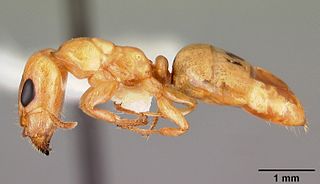
Gesomyrmex is a genus of ants in the subfamily Formicinae. The genus contains six extant species, known from the Indomalayan region, and nine fossil species. Of the extant species, four are known only from workers and two only from females. The extinct species "G. expectans" and "G. miegi", formerly placed in the genus, were excluded by Dlussky et al.., 2009.
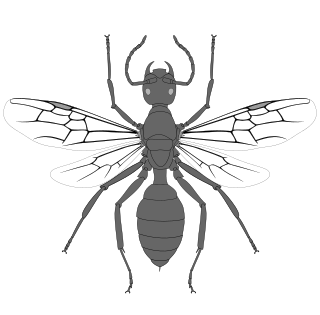
Armaniidae is an extinct family of ant-like hymenopterans known from a series of Cretaceous fossils found in Asia and Africa. Armaniidae has been suggested by several authors to belong to the family Formicidae as one of the stem-group subfamilies, Armaniinae; however, this position has not been taken up by most myrmecologists. The family currently contains seven described genera and thirteen described species.
Eotapinoma is an extinct genus of ants of the subfamily Dolichoderinae. It was described by Dlussky in 1988.

Usomyrma is an extinct genus of ant in the formicid subfamily Dolichoderinae. The genus contains a single described species, Usomyrma mirabilis, that is known from two Middle Eocene fossils which were found in Scandinavian amber in Denmark.

Casaleia is an extinct genus of ants in the formicid subfamily Amblyoponinae described by Pagliano & Scaramozzino in 1990 from fossils found in Europe. The genus contains four species dating from the Eocene to Miocene, Casaleia eocenica, Casaleia inversa, Casaleia longiventris, Casaleia orientalis.

Ponerini is a tribe of Ponerinae ants with 46 genera and 6 extinct genera.



